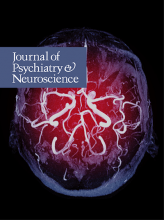A 24-year-old man was referred to the mood disorders clinic for depressive symptoms in the context of bipolar disorder. He was hospitalized at age 18 with a manic episode, received a diagnosis of bipolar disorder I. He was treated with lithium (Li) and had a partial response. He experienced no further manic episodes but had persistent subthreshold depression. Symptoms improved with valproic acid, but he experienced intolerable hair loss and weight gain, so valproic acid was withdrawn. When there was no improvement in his weight, he stopped Li against medical advice. He was hospitalized for a second manic episode 8 weeks later and Li was restarted. His symptoms improved, and he was stable on Li for 2 years before a gradual onset of depressive symptoms resulted in his referral.
The patient reported anhedonia, poor sleep, anxiety, social isolation and guilt about not having worked since leaving high school or entering university. He was not psychotic or suicidal, and there was no evidence of a mixed state. His Li level was in the high normal range. Because of poor sleep and disabling anxiety, quetiapine was started and titrated to 400 mg over several weeks. Symptom assessment confirmed significant social anxiety disorder. Benzodiazepine treatment was considered1,2 but rejected by the patient because his mother had a history of prolonged use of diazepam. He attended 16 sessions of individual cognitive behaviour therapy (CBT), resulting in his feeling able to take the bus and work part-time. Still, he rarely accompanied peers to after-work activities, struggled with attendance at work, did not date and avoided large family gatherings.
Because of partial response to CBT, the treatment team considered a trial of antidepressant medication. The risk of using antidepressants to treat bipolar disorder is that of switch to mania, but the patient was on mood stabilizers and had no manic symptoms while on medication. In such instances, the short-term risk of switch is thought to be no greater than 3%–4%.3 A selective serotonin reuptake inhibitor (SSRI) was initiated at low dose, and the patient was closely monitored. His anxiety improved, and he attended work regularly, socialized with peers and contemplated returning to university.
During a routine appointment 6 months later, the patient talked excessively, was jocular, and described decreased sleep and getting drunk every few days. He reported several other symptoms of mania and admitted to discontinuing quetiapine weeks earlier. The SSRI was withdrawn and quetiapine resumed, and his symptoms resolved. He did not become depressed, and his anxiety did not worsen over the next few months.
We found that more than 50% of patients with bipolar disorder followed in a mood disorder clinic had an anxiety disorder and that ongoing anxiety, particularly social anxiety, contributed to poor long-term outcome.4 Little is known, however, about treating anxiety in these patients.1,2,5 Antidepressants are first-line agents for treating social anxiety disorder,5 but whether they retain their efficacy for patients with social anxiety and bipolar disorder is not known. The controversy about using antidepressants in patients with bipolar disorder has predominantly focused on whether they have a role in treating bipolar depression;3,6,7 the literature is largely silent on their role in treating anxiety, which is highly comorbid with bipolar disorder.
The limited treatment options available for patients with comorbid anxiety suggest that the benefits of antidepressant treatment may outweigh the risks, particularly when psychotherapy has not led to adequate response. Nevertheless, concerns remain about affective switch or increasing cycle frequency,6 particularly in patients not adherent to mood stabilizers. Studies and meta-analyses have failed to confirm that SSRIs significantly increase the risk for an affective switch in patients taking mood stabilizers,3,6 but some have been criticized for poor monitoring of affective switch rates. The Canadian Network for Mood and Anxiety Treatments guidelines list antidepressants as second-line agents following quetiapine, Li and lamotrigine for treating bipolar depression.8 In this vignette, however, antidepressants were prescribed to treat social anxiety in a patient already on adequate doses of Li and an atypical antipsychotic.
Footnotes
Competing interests: None declared for S. Hassel. See www.cma.ca/jpn/editorial_board for G. MacQueen.
The information in this column is not intended as a definitive treatment strategy but as a suggested approach for clinicians treating patients with similar histories. Individual cases may vary and should be evaluated carefully before treatment is provided. The patient described in this column is a composite with characteristics of several real patients.
Psychopharmacology for the Clinician columns are usually based on a case report that illustrates a point of interest in clinical psychopharmacology. They are about 650 words long. Columns can include a bibliography that will be available only on the journal website.









